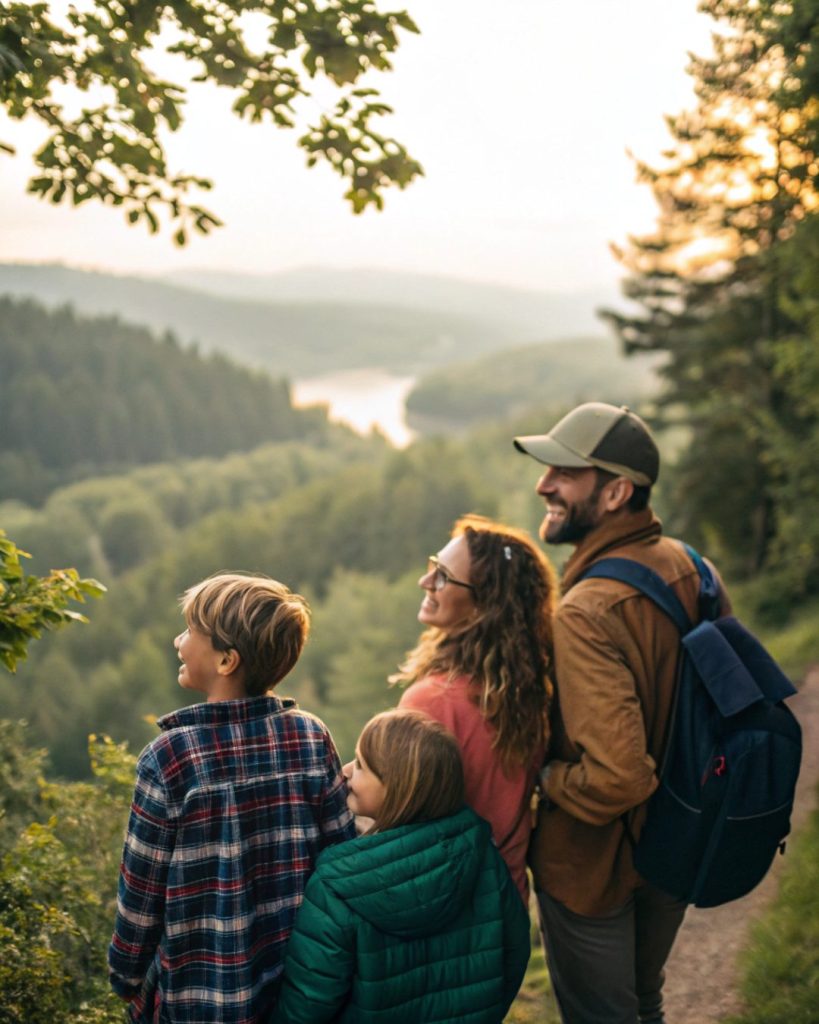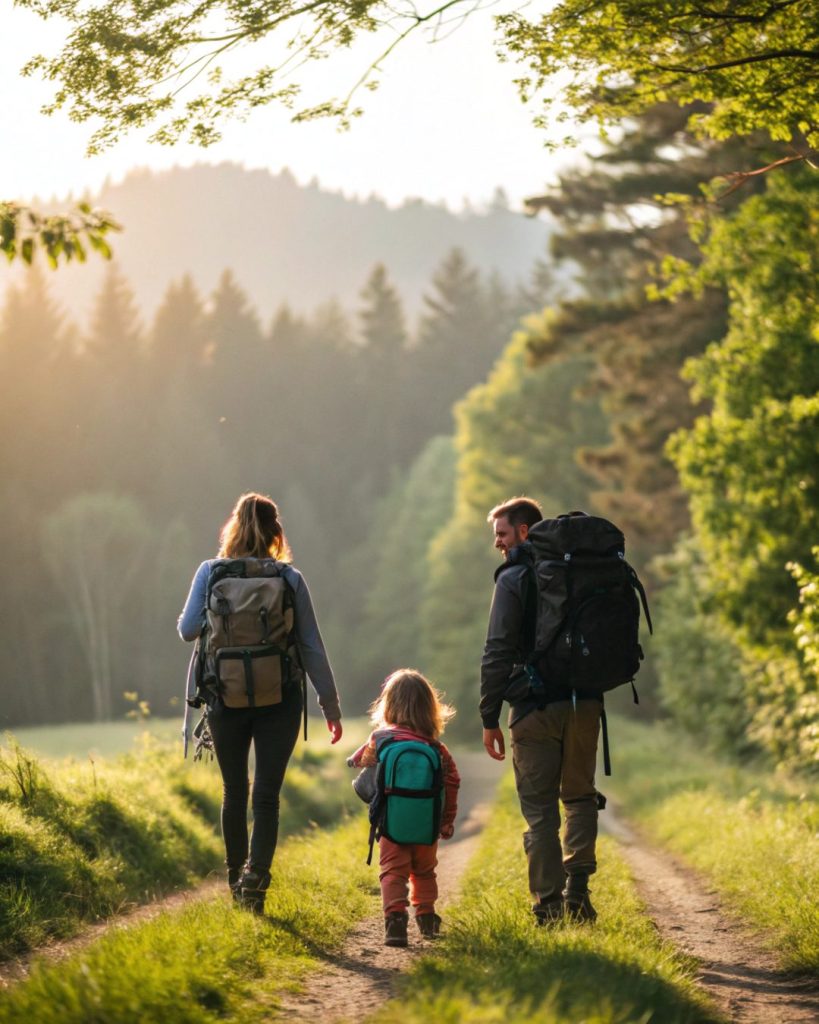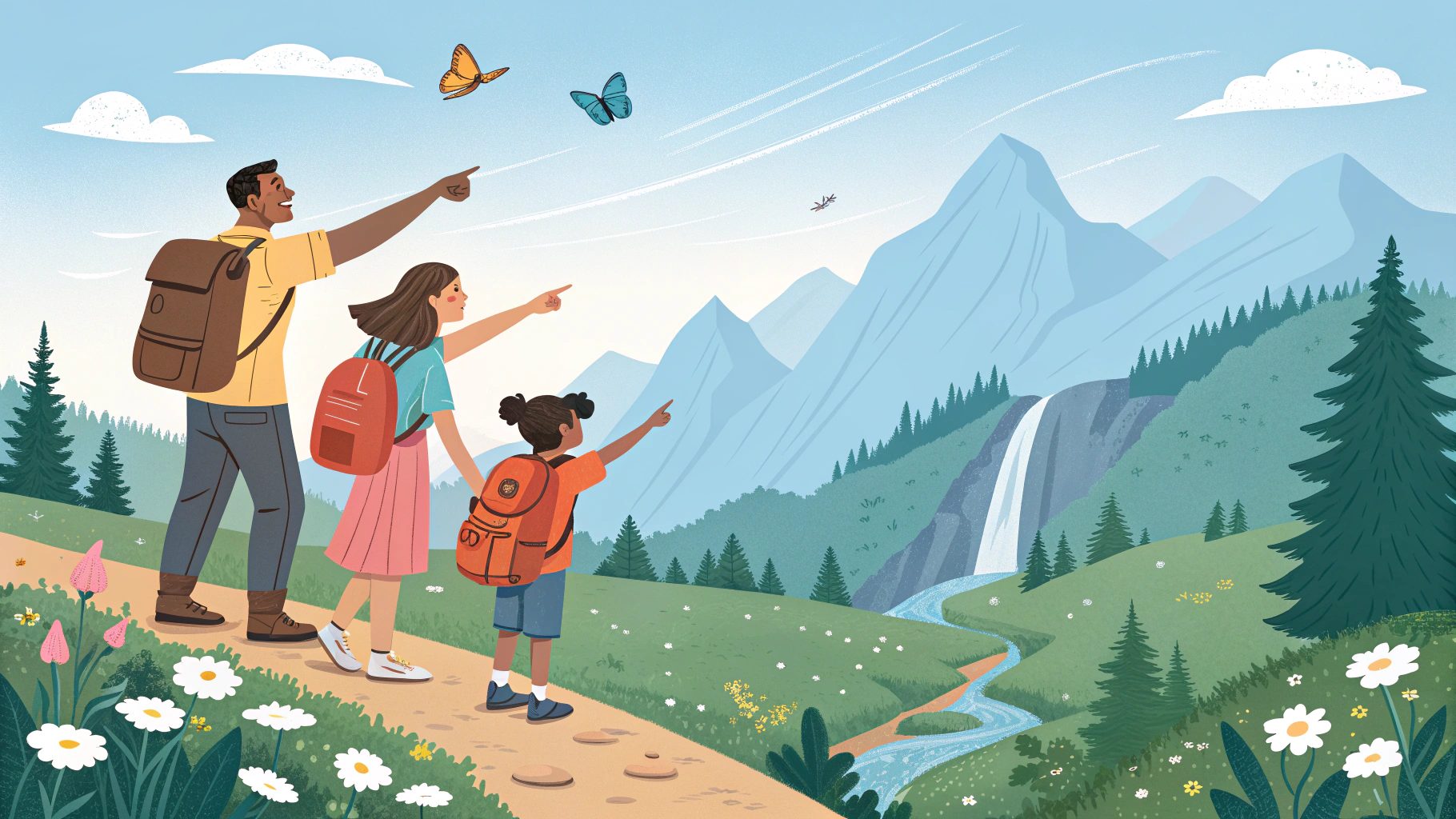Picture this: it’s 6 AM on a Saturday morning, and instead of the usual cartoons and cereal routine, my three kids are bouncing off the walls with excitement, stuffing sleeping bags into the car while arguing over who gets to carry the trail mix. Six months ago, the idea of taking Emma (14), Lucas (11), and little Sophie (7) on anything more adventurous than a trip to Target seemed impossible. Fast forward to today, and we’ve become a family that seeks out mountain trails, discovers hidden waterfalls, and yes – even survived a week of camping without WiFi.
If you’re reading this while your kids are glued to screens and you’re wondering how on earth other families seem to have these magical outdoor adventures together, I want you to know something: we started exactly where you are right now. The transformation from couch potatoes to adventure seekers didn’t happen overnight, and it certainly wasn’t without its challenges, tears, and a few “what were we thinking?” moments.
But here’s what I discovered along the way – family adventure trips aren’t just about the destinations or the Instagram-worthy photos (though those are nice too). They’re about creating space for your family to connect, grow, and build the kind of memories that your children will carry with them long after they’ve left home. And the best part? You don’t need to be an experienced outdoors person or have a massive budget to get started.
Why Family Adventure Travel Matters More Than Ever
Our E-book
In our hyper-connected, screen-dominated world, getting your family out on adventure trips has become more crucial than ever. I used to think that quality family time meant movie nights and board games, and while those things are wonderful, there’s something uniquely powerful about shared adventures in nature.
Breaking Free From Digital Distractions
Let’s be honest – how often does your family sit together without someone checking their phone, playing a video game, or watching TV? During our first family hiking trip, something magical happened around day two: the kids stopped asking about WiFi and started noticing things like the sound of birds, the patterns on tree bark, and the way shadows changed throughout the day.
Research shows that spending time in nature actually rewires our brains, reducing stress hormones and increasing creativity. But beyond the science, I can tell you from experience that there’s something about being outdoors together that strips away the usual distractions and allows for genuine connection.
Building Resilience Through Outdoor Family Activities
Adventure trips naturally present challenges – steep trails, unexpected weather, navigation puzzles. These aren’t obstacles to avoid; they’re opportunities for your family to problem-solve together and build resilience. I’ve watched my kids develop confidence and grit on adventures that they never would have discovered sitting at home.
Last summer, when we got caught in a sudden rainstorm during a family camping trip, instead of panic, we turned it into an adventure. The kids worked together to secure our campsite, and we spent the evening playing cards in the tent, listening to the rain. Sophie still talks about it as one of her favorite memories from the trip.
Planning Your First Family Adventure: Where to Begin

I know the idea of planning family adventure trips can feel overwhelming, especially if you’re new to outdoor activities. Trust me, I was the mom who Googled “how to make s’mores” before our first camping trip. But starting doesn’t require expertise – it just requires enthusiasm and a willingness to learn together.
Choosing Age-Appropriate Family Adventures
The key to successful family adventure travel is matching your activities to your youngest family member’s abilities while still keeping everyone engaged. With a wide age range in my family, I’ve learned to look for adventures that offer different levels of challenge within the same activity.
For example, when we go hiking, I choose trails that have interesting features along the way – waterfalls, rock formations, or wildlife viewing areas. The younger kids focus on reaching these mini-destinations, while the older ones might challenge themselves to carry extra gear or navigate using a map.
For families with toddlers (ages 2-4): Think short nature walks, beach exploration, or car camping at established campgrounds with facilities nearby.
For elementary-aged kids (ages 5-10): Day hikes up to 3 miles, beginner rock climbing, canoeing on calm waters, or multi-day camping trips with comfortable amenities.
For tweens and teens (ages 11+): More challenging hikes, backcountry camping, adventure sports like zip-lining or white-water rafting, or even multi-day wilderness expeditions.
Budget-Friendly Family Adventure Ideas
One of the biggest myths about family adventure trips is that they have to be expensive. Some of our most memorable adventures have cost less than a dinner out for the family. The key is focusing on experiences rather than expensive gear or exotic destinations.
Free and Low-Cost Adventures:
- Local state park exploration and geocaching
- Beach combing and tide pool investigation
- Urban adventure walks discovering street art and local history
- Backyard camping with stargazing and storytelling
- Community hiking trails and nature photography walks
Mid-Range Adventure Options:
- Weekend camping trips at state or national parks
- Guided nature tours or wildlife viewing experiences
- Adventure courses like zip-lining or tree-top adventures
- Family-friendly rock climbing at indoor gyms or outdoor beginner areas
- Canoe or kayak rentals for day trips
Remember, the goal isn’t to spend money – it’s to create shared experiences that bring your family closer together.
Essential Family Travel Planning Tips
After three years of trial and error (emphasis on the error part!), I’ve developed a system for planning family adventures that actually works. Here’s what I’ve learned about successful family vacation planning.
Involving Kids in Adventure Trip Planning
One game-changer for our family has been involving the kids in the planning process. When children help choose the destination and activities, they’re more invested in the experience and less likely to complain when things get challenging.
We start each adventure planning session with everyone sharing one thing they want to try and one thing they want to learn. Emma might want to try rock climbing, Lucas wants to see wildlife, and Sophie wants to collect interesting rocks. Then we look for destinations and activities that can incorporate everyone’s interests.
Creating Flexible Family Adventure Itineraries
I used to over-plan our trips, scheduling every hour with activities. What I learned the hard way is that the best family adventures have plenty of unstructured time for spontaneous discoveries and rest when needed.
Now I plan what I call “anchor activities” – one main adventure per day with plenty of buffer time around it. If we’re hiking to a waterfall, that’s our anchor activity. Everything else – the picnic lunch, the nature scavenger hunt, the impromptu rock skipping contest – happens organically around that central adventure.
Weather Backup Plans for Outdoor Family Fun
Mother Nature doesn’t always cooperate with our adventure plans, and I’ve learned to embrace this rather than fight it. Some of our best family memories have come from Plan B activities when the weather didn’t cooperate.
I always pack indoor activities for camping trips – cards, travel games, coloring books. But I also try to find weather-appropriate alternatives that still feel adventurous. Rainy day might mean visiting a local indoor rock climbing gym or exploring caves. Hot weather might shift our hiking plans to early morning with afternoon time at a swimming hole.
Building Outdoor Skills as a Family Unit

One of the unexpected joys of family adventure trips has been learning new skills together. There’s something uniquely bonding about being beginners at something as a family – everyone’s on equal footing, and you can support each other through the learning process.
Nature Education Through Hands-On Experiences
Our adventures have become incredible opportunities for natural learning. The kids have learned about geology by examining rock formations, biology by observing wildlife, and geography by reading maps and using compasses. But unlike classroom learning, these lessons stick because they’re connected to real experiences.
Sophie became fascinated with bird identification after we heard an unusual call on a hiking trail. Now she carries a small bird guide and keeps a nature journal of our discoveries. Lucas developed an interest in weather patterns after we got caught in a sudden thunderstorm and had to take shelter. These authentic learning experiences have been far more impactful than any textbook.
Teaching Kids Basic Adventure Safety
Safety skills are crucial for family outdoor activities, but they don’t have to be scary or overwhelming. I teach safety through games and hands-on practice rather than lectures about all the things that could go wrong.
We practice “stay together” signals, learn to identify poisonous plants through fun identification games, and discuss basic first aid through role-playing scenarios. The kids know how to use a whistle, what to do if they get separated from the group, and basic wilderness safety principles.
Developing Family Teamwork Skills
Adventure trips naturally create opportunities for teamwork and cooperation. Setting up camp, navigating trails, solving problems – all of these require family members to work together and support each other.
I’ve watched my kids develop leadership skills, learn to compromise, and discover how to contribute according to their abilities. Emma has become our unofficial photographer and trip documentarian. Lucas excels at map reading and navigation. Sophie is amazing at spotting wildlife and finding interesting natural treasures.
Creating Lasting Memories Through Family Bonding Experiences
The real magic of family adventure trips happens in those unplanned moments – the conversations that unfold during long car rides, the quiet bonding that happens around a campfire, the problem-solving that brings you closer together when things don’t go according to plan.
The Power of Shared Challenges
There’s something about facing challenges together that creates deep family bonds. When we hiked our first mountain trail together, there were moments when we all wanted to quit. Lucas was complaining about his pack being too heavy, Sophie was tired, and honestly, I was questioning my sanity for attempting it.
But we encouraged each other, shared the load, and celebrated together when we reached the summit. That shared accomplishment became a family story that we still reference when facing other challenges. “Remember when we thought we couldn’t make it up that mountain?” has become our family shorthand for “we can do hard things together.”
Unplugged Family Connection Time
One of the most unexpected benefits of our adventure trips has been the quality of conversation and connection that happens when we’re away from our usual distractions. Without screens competing for attention, we actually talk to each other – really talk.
Some of my most meaningful conversations with my teenagers have happened on hiking trails or around campfires. There’s something about the rhythm of walking or the intimacy of firelight that creates space for deeper sharing. Emma has opened up about friendships, Lucas has shared his dreams and worries, and Sophie asks the most wonderfully profound questions about life and nature.
Photography and Memory Documentation
While I don’t want to be the parent who experiences everything through a camera lens, I have found that involving the kids in documenting our adventures adds another layer of engagement and creates lasting keepsakes of our experiences.
Each child has a responsibility for capturing different aspects of our trips. Emma focuses on landscape and artistic shots, Lucas documents the action and adventure moments, and Sophie collects “treasure photos” of interesting things she finds. When we return home, we create digital photo albums together, which reinforces the memories and gives us something tangible to look back on.
Overcoming Common Family Adventure Challenges
Let me be completely honest with you – family adventure trips aren’t always the picture-perfect experiences you see on social media. There are meltdowns, arguments, moments when you question your sanity, and times when you wonder if it would have been easier to just stay home and watch Netflix.
Dealing with Different Fitness Levels and Interests
With kids ranging from 7 to 14, managing different fitness levels and interests can be tricky. I’ve learned to build flexibility into our adventures and to celebrate individual achievements rather than expecting everyone to perform at the same level.
For hiking, we use what I call the “buddy system plus” approach. Faster hikers pair with slower ones, but we also build in regular rest stops where everyone can regroup. At these stops, we do mini-activities like nature scavenger hunts or photography challenges that keep everyone engaged regardless of their hiking pace.
Managing Expectations and Avoiding Meltdowns
Adventure trip meltdowns are almost inevitable, especially with younger children. The key is preparation and having strategies ready before you need them.
I always pack what I call my “emergency engagement kit” – snacks, small toys, travel games, and activities that can redirect attention when someone is struggling. I also talk with the kids before each trip about what to expect, including potential challenges, so they’re mentally prepared for difficult moments.
Safety Considerations for Family Outdoor Activities
Safety is obviously paramount when you’re taking children on adventures, but I’ve learned that over-emphasizing dangers can create anxiety rather than preparedness. Instead, I focus on teaching practical safety skills and making good decisions.
We always tell someone our plans and expected return time. Everyone carries a whistle and knows basic emergency procedures. I carry a well-stocked first aid kit and have basic wilderness first aid training. But I also try to model calm problem-solving and good judgment so the kids learn to assess situations thoughtfully rather than fearfully.
Growing Your Family’s Adventure Portfolio
As your family becomes more comfortable with adventures, you’ll naturally want to expand your horizons and try new challenges. The progression from backyard camping to multi-day wilderness trips doesn’t happen overnight, but it’s incredibly rewarding to watch your family’s confidence and skills grow.
Seasonal Family Adventure Ideas
Each season offers unique opportunities for family adventures, and embracing seasonal activities helps maintain year-round engagement with the outdoors.
Spring Adventures: Wildflower hikes, bird migration watching, maple syrup farm visits, Easter egg hunts in state parks, and early season camping as weather permits.
Summer Family Fun: Beach exploration, lake activities, longer hiking adventures, family-friendly festivals, outdoor concerts, and extended camping trips.
Fall Outdoor Activities: Leaf-peeping hikes, apple picking adventures, harvest festivals, cooler weather camping, and preparation activities for winter adventures.
Winter Family Activities: Snowshoeing, sledding adventures, winter wildlife tracking, holiday light tours, and cozy cabin retreats with outdoor exploration.
Building Adventure Confidence Over Time
Confidence builds gradually, and I’ve learned to celebrate small victories along the way. Our first “big” adventure was a two-night camping trip just 30 minutes from home. It felt huge at the time, but it gave us the confidence to try longer trips and more remote locations.
Now, two years later, we’re planning a week-long backcountry adventure that would have seemed impossible when we started. The key has been gradually increasing challenges while building skills and confidence along the way.
Advanced Family Adventure Planning
As your family’s adventure skills develop, you can start incorporating more complex planning elements like multi-day itineraries, backcountry permits, and specialized gear. But remember – advanced doesn’t necessarily mean more expensive or more remote. It might mean better planning, more independence, or taking on leadership roles within your group.
I now involve my older kids in researching destinations, understanding weather patterns, and even helping with budget planning. These skills will serve them well when they start planning their own adventures as adults.
The Transformative Power of Family Adventure Travel
After three years of prioritizing family adventure trips, I can honestly say that these experiences have transformed not just how we spend our free time, but how we relate to each other as a family. The confidence my children have gained, the problem-solving skills they’ve developed, and the deep connections we’ve built have impacted every area of our lives.
Life Skills Learned Through Adventure
Beyond the obvious benefits of physical fitness and outdoor knowledge, adventure trips have taught my kids invaluable life skills. They’ve learned persistence through challenging hikes, adaptability when plans change due to weather, teamwork when setting up camp, and resilience when things don’t go perfectly.
These skills translate directly to academic challenges, social situations, and future life challenges. When Lucas faces a difficult math problem now, he often references the persistence he learned climbing difficult trails. When Emma deals with friendship drama, she draws on the conflict resolution skills she developed during camping trips when space is limited and everyone needs to get along.
Strengthening Family Relationships
The time we spend together on adventures, away from the usual distractions and routines, has deepened our relationships in ways I never expected. We’ve learned to support each other through challenges, celebrate each other’s achievements, and simply enjoy each other’s company.
The stories and inside jokes that have emerged from our adventures have become part of our family culture. We reference “the great tent catastrophe of 2023” when we need to laugh about mistakes, and “Sophie’s eagle discovery” when we want to celebrate careful observation skills.
Creating a Legacy of Adventure
Perhaps most importantly, I’m creating a legacy of adventure and outdoor appreciation for my children. They’re learning that happiness doesn’t come from material possessions or screen time, but from experiences, challenges, and connections with nature and each other.
I hope that when they’re adults with their own families, they’ll remember these adventures and want to create similar experiences for their children. I’m planting seeds for a multigenerational love of nature and adventure that will extend far beyond my own parenting years.
Your Next Step Into Family Adventure
If you’ve made it this far, you’re clearly interested in creating more adventure in your family’s life. I want to encourage you to start small but start now. You don’t need perfect gear, extensive outdoor experience, or a huge budget. You just need willingness to try something new and the courage to step outside your comfort zone with your kids.
Starting Your Family Adventure Journey
Begin with a simple day adventure close to home. Visit a local state park, try a short hiking trail, or spend a night car camping. The goal isn’t to prove anything or create the perfect experience – it’s to take the first step and see how your family responds to outdoor adventures.
Pay attention to what your kids enjoy most and what challenges them appropriately. Use this information to plan your next adventure, gradually building skills and confidence while maintaining the fun factor that keeps everyone engaged.
Resources for Family Adventure Planning
Don’t try to figure everything out alone. Join online communities of adventure families, connect with local outdoor organizations, and take advantage of the many resources available for family outdoor activities. Many state parks offer guided family programs that are perfect for beginners.
Consider taking a family wilderness skills class or attending outdoor gear demonstrations. The more you learn, the more confident you’ll become, and the more opportunities you’ll see for family adventures.
Remember, the goal isn’t to become extreme adventurers overnight. The goal is to create meaningful experiences, build family connections, and help your children develop a lifelong love of nature and adventure. Every small step in that direction is a victory worth celebrating.
Embracing the Adventure Mindset
As we conclude this journey together, I want to leave you with this thought: family adventure trips aren’t really about the destinations, the gear, or even the activities. They’re about cultivating an adventure mindset – a willingness to try new things, embrace challenges, and find joy in shared experiences.
This mindset will serve your family well beyond your outdoor adventures. It will help you approach life’s challenges with curiosity rather than fear, find solutions rather than dwelling on problems, and create connection rather than letting routine and busyness drive your relationships.
The mountains, trails, and campgrounds are just the setting. The real adventure is watching your family grow closer, seeing your children develop confidence and resilience, and creating the kind of memories that will sustain your relationships for years to come.
Your adventure doesn’t have to look like anyone else’s. It doesn’t have to involve mountain climbing or wilderness camping. It just has to involve stepping outside your normal routine, trying something new together, and being open to the magic that happens when families share challenges and discoveries.
So pack that day pack, charge those cameras, and take the first step. Your family’s adventure story is waiting to be written, and I promise you – it’s going to be amazing.
“The best adventures are the ones we share with the people we love most. Every trail we hike together, every challenge we overcome as a team, and every sunset we watch in wonder becomes part of the fabric of our family story. These aren’t just trips – they’re the memories our children will carry forever.”
Your adventure begins with a single step. What will yours be?





